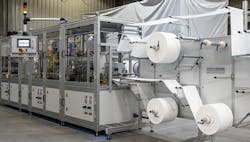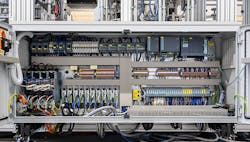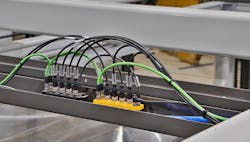Times change, but does integrated control and safety?
As we emerge from the COVID-19 shutdown, where staffing requirements have changed because of remote connectivity, time-sensitive networking (TSN) is changing the rules of deterministic control.
Times are changing fast. And assessments of integrated safety and control have changed over the past year.
COVID restrictions and TSN advancements have impacted integrated safety and control, but other new technologies and developments are having equally significant effects.
“The demand for integrated machine safety technologies in manufacturing continues to increase with the increase of manufacturing safety in general,” says Mark Eitzman, functional safety tech. machinery, TUV Rheinland, cybersecurity specialist, TUV Rheinland, sales engineer/safety and project manager, Integrated Mill Systems in Willoughby, Ohio. “The effects of the COVID-19 pandemic on these trends have perhaps helped non-subject-matter safety experts better understand the aspects of risk. These people would include executives that are typically involved in the decisions about investment involving manufacturing assets but don't have a background in safety or risk reduction.”
Specifically, what seems to be improved is the understanding that risk, inherently, is not about absolutes—an incident will happen or will not happen. “Risk is always in between and thus is represented as a percentage,” explains Eitzman. “Subsequently, there is a better understanding that risk reduction measures do just that—reduce risk whether it is about the infection of a virus or experiencing a safety incident in a manufacturing plant. These measures will not prevent an incident 100%, or make it safe; rather, they can reduce risk to an acceptable level.”
Now, more than ever, adding the expense and complexity of integrating safety into an automation project seems to be more acceptable due, in part, to this refinement in the understanding of the benefits of risk reduction, says Eitzman. “As society learned about the risk reduction measures for the pandemic—vaccines, masks, social distancing—there was a realization that some worked better than others,” he notes. “It took layers of measures, and some were much more convenient and ultimately more effective. Vaccines appear to be quite effective and can be seen as an equivalent to integrated safety.”
Given the integrated nature of the solutions, it appears to be more effective than masks or social distancing, given the realities of day-to-day life. “Vaccines can be viewed as equivalent to integrated safety technologies,” observes Eitzman. “Manufacturers can apply these same aspects to their expectations of solutions for improved safety and the benefits of those solutions that are integrated into the normal operations of manufacturing assets rather than additions to normal operations.”
Plan for safety
All factories, plants and manufacturers are required to develop safety plans, procedures and guidelines as part of their standard operating procedures. “Machinery and assembly lines need real-time critical data as the dangers are associated with them if their data requirements are not met,” explains Sanaz Kanani, product manager, network & IIoT, Weidmüller. “By implementing a TSN network, hazards can be classified in terms of data management and efficient data-delivery procedures. Before the pandemic, industrial automation was slowly growing into the fourth industrial revolution. After the global shutdown due to COVID-19, the whole world as well as the manufacturing sector experienced a massive shift.”
More than 50% of manufacturer’s workforce were unavailable to perform their function on-site. Remote operating, troubleshooting, maintenance and commissioning became a hot topic of 2020, says Kanani. “History teaches us that short-term measures taken in response to global crises lead to long-term changes,” she explains. “Hence, manufacturers who formerly used conventional production methods and got through the pandemic are highly stimulated to embrace new technology to stay admissible in the market.”
Another main challenge after the pandemic is supply chain. Supply chains are experiencing an unprecedented level of disturbance. “By applying Industry 4.0 an Industrial IoT solutions to a business, better awareness, control and data visibility will be achieved over the entire supply chain, and it helps manufacturers become more efficient in tracking inventory, quality and optimization related to logistics,” says Kanani.
Digitalization offers machine builders and manufacturing companies new opportunities to increase their productivity levels and differentiate themselves from the competition through data-driven services, Kanani states. “Artificial Intelligence (AI) and the resulting data-analysis methods open a new approach to product developments,” she explains. “They also form the basis for service-oriented business models. Predictive maintenance is a solution that is already available, and that creates considerable added value by reliably predicting machine behavior.”
Industrial Ethernet is the backbone for Industry 4.0. “Without digital, standardize and decentralize interfaces the Industrial Internet of Things (IIoT) will not be possible,” says Kanani. “Time-sensitive networking standards focus on time synchronization, latency, reliability and resource management and offer a scalable, predictable approach to deterministic networking over standard Ethernet. TSN requires all network equipment to implement IEEE 802.1AS, which defines standards for timing and synchronization. With 802.1AS-rev, TSN also defines an interoperable, uniform method for synchronizing distributed clocks in the network. This would ensure that the data is delivered as needed and can contribute to the improvement of safety levels in the factory.”
Ever-changing moods
Figure 2: Machine cabinet concept for medical face masks uses safety technology.
Manufacturers trying to keep pace with the ever-changing market landscape and the current COVID variant situation are faced with many challenges (Figure 1). “Digital technologies with safety and security integrated provide solid answers,” explains John D’Silva, safety technology manager, Siemens Industry. “Digitalization is now at the forefront of everything. Partly due to the pandemic, we are witnessing the majority of big organizations, in one form or the other, quickly embracing digital manufacturing because of its ability to simplify the design process and make it much faster. When everything from idea to execution can be simulated on a screen using one seamless platform, time to market can be shortened drastically, but that is only one element of the bigger picture. Digitalization ties the entire manufacturing process together, from initial concept to field service. Digitalization enables production to quickly adapt to the changing demands of customers, improve profitability and long-term viability.”
At Siemens, for example, during the design process, simulation, an element of digitalization that creates a digital twin of each component in a device or machine, lets designers and builders explore what-if scenarios easily, even with safety and security, inexpensively and quickly, despite product size or complexity.
“Designers can work on the digital twin from any location, at the office or at home, and do the work, especially during COVID, with all the restrictions that keep changing,” explains D’Silva. “In addition, with the advanced functionalities built into controllers and I/O modules, one common advantage is they have built-in diagnostics—no programming required—that reduces design time and cost. Additionally, all of this diagnostic data can easily and securely be accessed via the web-server functionality, from anywhere in the world, reducing the number of people needed at the machine and reducing downtime, especially in the current pandemic.”
Another important aspect is that the delivery of parts has been hugely impacted by COVID, so, for existing machines to minimize downtime and availability of spares, it is very important that the automation solution with safety and security integrated is comprised of robust and reliable products, says D’Silva.
“The global pandemic has increased the demand for data volume, which must be transferred in parallel to time-sensitive data through the network and has shown the critical need to access real-time data as fast as possible, whether it is the manufacturing industries or healthcare, so the appropriate response can be equally quick and efficient,” he says. “At Siemens, this means ensuring low latency and deterministic data exchange. Profinet is the communication standard for digital transformation. Profinet over TSN comes with the benefits of scalability and flexibility. Plus, the Ethernet chip will now be a TSN-Ethernet chip. ProfiSafe is an integrated profile that resides in the Profinet structure, providing users with safety to quickly overcome the challenges posed by COVID (Figure 2).”
Convergence as accelerator
“Everything is being implemented much faster,” says Michael Flesch, safety systems product manager at Turck. “IO-Link Safety is becoming more important, and in the next two years we will see the first devices and also masters for Ethernet/IP with CIP safety and Profinet with Profisafe; other protocols are possible. Single-pair Ethernet (SPE) is on everyone's lips, as IT and OT are growing together more.”
Safety of machines is no longer conceivable without IT security of products and controls, says Flesch. “They influence each other,” he explains. “Due to the ever-increasing networking of machines in companies, security of the IT is also needed to ensure the safe operation of the systems. In the next few years, we will see products ranging from sensors and controls to actuators that are easy to parametrize into control systems and can be securely integrated into the network in the machine and plant. For this reason, the devices must be easy to integrate into applications and controllers.”
Networking is becoming increasingly important. “OPC UA and MQTT are the standards for machine-to-machine communication,” says Flesch. “Whether it is the automated guided vehicle (AGV) in logistics that docks with a palletizer and picks up a pallet there, securely coupling its emergency stop with that of the robot, or a tool securely connecting with the joint of a robot. Open, safe communication between different machines from different suppliers is becoming increasingly important. At the same time, the demands on design, planning and programming are increasing, so IIoT is not possible without open safe communication across machines. I am sure we will not need much longer to find artificial intelligence in safe machine controls. Just imagine that you drive down a hall with a safe scanner and learn the fixed conditions there.”
If you combine this information with a driving task, an AGV can process it independently, explains Flesch. “Obstacles that are newly added can be recognized, possibly stored as new conditions, and bypassed,” he says. “The current situation in which we all live, shows me that we all try to cope with it, COVID acts like a fire accelerator.”
Bring the digital boom
Figure 3: Facilities needed to run on limited staff on-site or, in some cases, be run remotely or virtually.
The year 2020 onward has in many cases seen an acceleration toward digitalization and a need for integration to provide that single source of truth as facilities needed to run on limited staff on-site or, in some cases, be run remotely or virtually (Figure 3).
“Disconnected data and numerous interfaces take time to interpret and act on, many times proportional to the availability of boots on the ground,” explains Adrian Fielding, general manager, Honeywell. “Digitalization with integration such as integrated control and safety system (ICSS) solutions presented opportunities to be able to operate securely and safely with significantly fewer people on-site. This shift toward creating and managing datasets, both ICSS and safety lifecycle, rather than separate systems and document sets that traditionally sat on shelves, enables both operators and system providers to drive out systematic errors as we reduce the amount of times we need a human to touch a design or operational task.”
Taking the source data digitally all the way through the safety instrumented system (SIS) lifecycle drives consistency in all lifecycle phases with an ability to compare that source design data to what is really happening through advanced event analytics, says Fielding. “All this is made possible through the integration of design and operational data, tools and systems,” he says.
Figure 4: The “integrated” in ICSS is happening on the back end where the safety system provides data on its status to the control system and to the operator console/display.
A large part of safety hasn’t changed, and it shouldn’t, explains Fielding. “As systems become more capable and more complex, there are failure modes that can creep in,” he says. “That’s why process industry norms such as IEC 61508/11 call for a control system that is independent from the safety system. The ‘integrated’ in ICSS is happening on the back end where the safety system provides data on its status to the control system and to the operator console/display (Figure 4). As code becomes more complex, the chance for programming errors rises. SIS programming is deliberately simpler to avoid programming errors.”
Integrated, programmable machine safety continues to prove itself as the optimal approach, declares Sree Swarna Gutta, I/O product manager, Beckhoff Automation. “Our customers appreciate how adding safety to the standard controls and networking platform enhances machine safety, speeds up commissioning and offers greater data insights,” she explains. “It also helps you put more safety technology in more places (Figure 5).”
Stability in unstable times
Figure 5: Integrated, programmable machine safety continues to prove itself as the optimal approach.
“Many of our customers have found ways to maintain stable production despite COVID restrictions,” says Beckhoff’s Gutta. “But this often means splitting shifts to limit the number of people on the plant floor at any given time. In these situations, effective safety technology is even more important. It ensures that machine operators are safe even when working alone. It also simplifies remote troubleshooting and maintenance by engineers, especially compared to hard-wired safety controllers.”
Operationally, machine hazards are pretty unaffected by the pandemic, claims Ronald Crosby, account manager, Pepperl+Fuchs. “However, the explosion of automation, specifically around material handling, logistics and autonomous entities, that has happened within the pandemic, has rendered assessments to be ever more necessary, which of course means the sheer volume of assessments should be up,” he explains. “Further increasing the importance of a good risk assessment and remediation is the fact that due to staffing gymnastics this pandemic has brought about, people unfamiliar with the machine and its hazards are potentially exposed in this current reality and should be protected. This staffing flexibility is due to cross-training on the equipment, or a minimally trained/untrained operator filling in for the usual operator, who may be out with COVID; either way the plant needs to run in a safe manner.”
Noncontact, remote, via IIoT networking, and autonomous operation are the current drivers for innovation within the automation and functional machine safety space, Crosby continues. “Although not a part of a traditional risk assessment, noncontact, presence-detection sensors can not only make sure an operator is within a safe area of the machine, it could also be used to help maintain social-distancing requirements within a factory environment, in the same way that temperature sensors can be incorporated to constantly monitor employee internal temperatures and RFID can be installed to help with contact tracing,” he says.
Also read: Where does integrated control and safety stand?
“As we come out on the other side of this pandemic, it will be important to remember that many of the advances made to keep industry personnel safe will still be needed into the future,” Kris Dornan, marketing manager, large controllers, Rockwell Automation, reminds. “The ability to safely separate workers will still be applicable after the pandemic. Especially in an industry that is losing seasoned employees and can’t afford downtime, protecting workers from illnesses is beneficial. Furthermore, one of the keys to an integrated control and safety system is the ability to safely maintain a system without taking it down. The ability to change a system to a safe speed or use safe torques for maintenance needs continues to enable high availability of systems. “
Although the pandemic forced a need for technology to meet new demands quickly, there has always been a push for remote operations, stresses Dornan. “The continued evolution of cloud and edge technologies offer a future with untethered control, which could then allow for safer control of hazardous locations. Another important technology at play is the push for software/hardware as a service (SaaS/HaaS) and how the future of control is married to the future of annual reoccurring revenue (ARR). It will be critically important for control vendors to think of how integrated control and safety systems play into the SaaS and HaaS space.”
Security first
“The increase in remote operations since 2020 has increased the need for secured connectivity as more external connections to plant systems are established, whether to the business planning and control system (BPCS) or, more rarely, the SIS,” says Sergio Diaz, DeltaV SIS product manager, Emerson. “On the rare occasion that off-site personnel need to remotely interact with the SIS, it will typically be to set a bypass, perform a reset, pull records or check alarms rather than changing configuration. In many cases, these SIS changes will be performed through the BPCS. This overall trend toward more remote connectivity to the BPCS means cybersecurity is more important than ever.”
Securing an SIS goes beyond simply separating the safety system, Diaz explains. “Even an interfaced SIS requires proper cyber protections,” he says. “Integrated safety and control makes it easier to keep remote interactions secure to both the BPCS and the noncritical components of the SIS. In an integrated system, validation of the interaction between the BPCS and SIS is built-in, whether the BPCS is accessed internally or from a remote connection. Integrated systems also typically operate with fewer custom-engineered connections, thereby reducing the number of potential contact points that could be compromised via a remote connection.”
With more remote connectivity to plant systems due to COVID restrictions, the need for improved cybersecurity has only increased, better positioning the integrated control and safety system as the ideal choice for operations, notes Diaz. “Additional users accessing internal systems from outside the plant make it more essential than ever to ensure that layers of defense against cybersecurity intrusions are kept up to date,” he says.
“Fewer IT and OT personnel on-site means teams have fewer resources to commit to updating systems to ensure the latest, strongest protections are in place,” emphasizes Diaz. “Because integrated systems can share a set of defense-in-depth layers for many common defense systems, including antivirus, whitelisting and firewalls, there are typically fewer systems to maintain, monitor and update. Having fewer systems makes it easier for a smaller team to manage cybersecurity layers. Moreover, internal SIS defense measures provide extra protection for safety-critical features, reducing or eliminating custom-engineered interfaces that are time- and labor-intensive to update and secure.”
As technology evolves—often quickly—there are more elements to check and understand in any assessment. To help ensure safe operations, deeper reviews of the functioning of all system components together as designed are needed, says Ted Cowie, vice president, sales, safety and industrial products, Motion.
“COVID restrictions may make it a little more complicated for the in-person activity, but ultimately they do not impede what needs to be done,” says Cowie. “TSN is a key factor to be tested and validated since it affects the responsiveness and, therefore, the safety of these automated operations. I cannot speak to every new technology that affects automated solutions, but one area that also extends to these solutions is system cybersecurity. It is increasingly important for any connected system to be protected from unauthorized digital intrusion, whether malicious or accidental.”
About the Author
Mike Bacidore
Editor in Chief
Mike Bacidore is chief editor of Control Design and has been an integral part of the Endeavor Business Media editorial team since 2007. Previously, he was editorial director at Hughes Communications and a portfolio manager of the human resources and labor law areas at Wolters Kluwer. Bacidore holds a BA from the University of Illinois and an MBA from Lake Forest Graduate School of Management. He is an award-winning columnist, earning multiple regional and national awards from the American Society of Business Publication Editors. He may be reached at [email protected]

Leaders relevant to this article:





